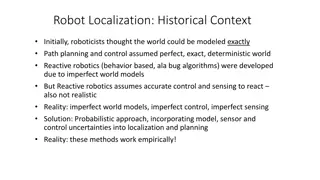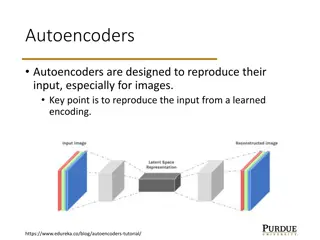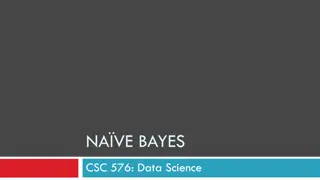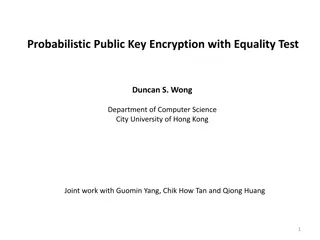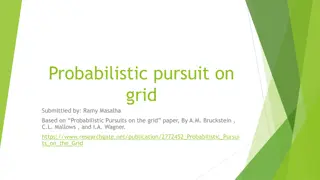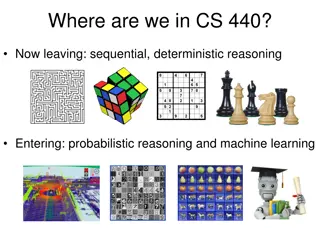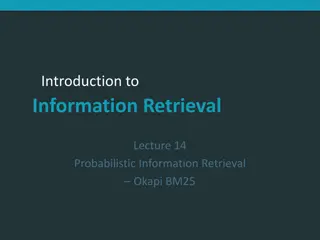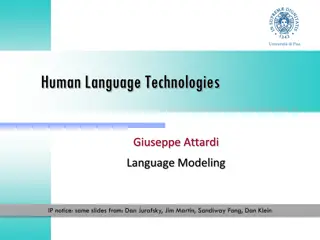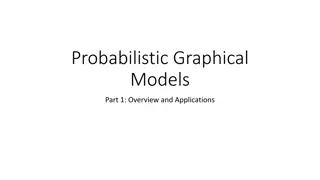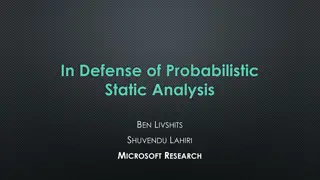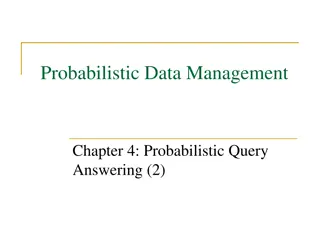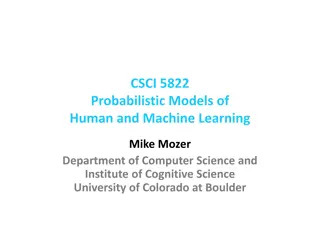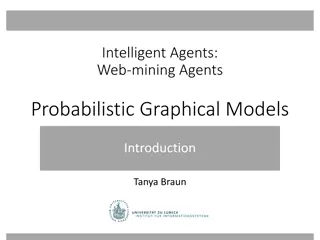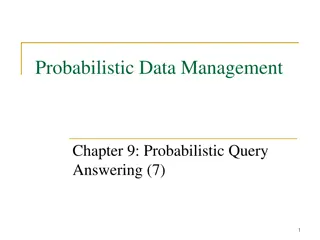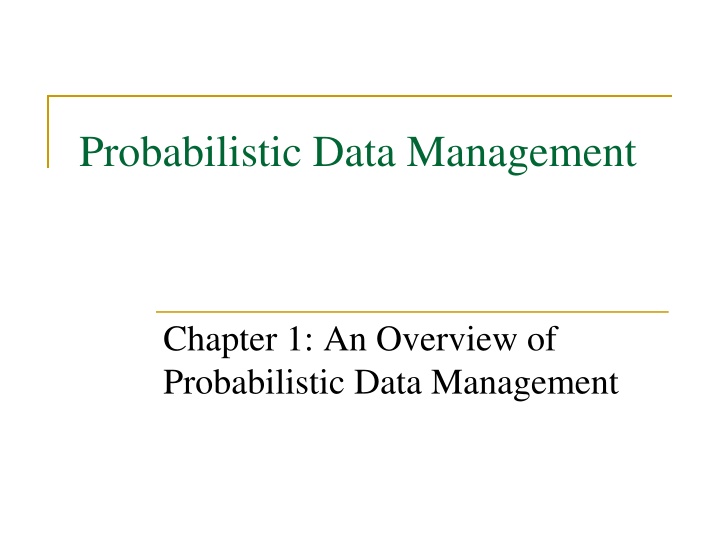
Overview of Probabilistic Data Management
This chapter provides an insight into uncertain data management, discussing the types of uncertain data, causes, importance, and historical background. It covers topics such as data collection, transmission errors, and existing systems in the field.
Download Presentation

Please find below an Image/Link to download the presentation.
The content on the website is provided AS IS for your information and personal use only. It may not be sold, licensed, or shared on other websites without obtaining consent from the author. If you encounter any issues during the download, it is possible that the publisher has removed the file from their server.
You are allowed to download the files provided on this website for personal or commercial use, subject to the condition that they are used lawfully. All files are the property of their respective owners.
The content on the website is provided AS IS for your information and personal use only. It may not be sold, licensed, or shared on other websites without obtaining consent from the author.
E N D
Presentation Transcript
Probabilistic Data Management Chapter 1: An Overview of Probabilistic Data Management
Objectives In this chapter, you will: Get to know what uncertain data look like Explore causes of uncertain data in different applications Learn the importance of studying uncertain data management Become aware of the classifications of uncertain data 2
Objectives (cont'd) Discover the pros and cons of uncertain data management, compared with traditional certain data management Become familiar with the history of uncertain data management, including some existing systems 3
Outline Introduction Applications of Probabilistic Data Management Classifications of Uncertain Data Comparisons: Uncertain vs. Certain Data The Existing Systems 4
Introduction Uncertain data are pervasive in real-world applications A.k.a. probabilistic data / imprecise data / inaccurate data / noisy data Data uncertainty may occur, during: Data collection probability Data transmission reported data Data processing actual data 5
Data Collection Data imperfect collection devices are sometimes Sensors Abnormal sensor readings RFID readers Miss-read Cross-read 6
Data Collection (cont'd) Data extraction techniques are often inaccurate Information extraction from unstructured text Different techniques can produce different extraction results Technique 1 Address: West Sugar Road Technique 2 Address: Sugar Road unstructured text I live at 203W Sugar Road 7
Data Transmission During the data transmission, errors may occur Sensor networks Packet losses fewer or biased samples Transmission errors erroneous sensory data sink sensor network 8
Data Transmission (cont'd) During the data transmission, errors may occur Global Positioning System (GPS) refraction reflection 9
Data Processing Data can be imprecise, when we manipulate the data Privacy preserving Add synthetic noises to protect users' privacy before publishing data Lossy data compression Trade the data accuracy for space Data integration Merge data from multiple data sources 10
Outline Introduction Applications of Probabilistic Data Management Classifications of Uncertain Data Comparisons: Uncertain vs. Certain Data The Existing Systems 11
Real-World Applications Applications of Probabilistic Data Management Sensor networks Location-based services Moving object search Data extraction and integration Privacy preserving 12
Applications (1) Sensor Networks Causes of data uncertainty Environmental factors Low battery power Packet losses 13
Applications (2) Global Positioning System (GPS) Causes of data uncertainty Reflection or refraction of the satellite signal refraction reflection 14
Applications (3) Data Extraction and Integration Causes of data uncertainty the confidence that a document is true Unreliability of data sources Doc 1 0.2 Doc 2 0.4 a document entity Doc l 0.3 near duplicate documents data sources 15
Applications (4) Privacy Preserving Medical data analysis Age Sex 21 50 51 Zipcode 11000 37000 31000 Disease pneumonia flu AIDS Generalize attribute values to uncertain intervals M M M Avoid identifying sensitive information of patients Age [20, 30) [50, 60) [50, 60) Sex Zipcode M [10000, 20000] M [30000, 40000] M [30000, 40000] Disease pneumonia flu AIDS 16
Applications (5) Privacy Preserving Location-Based Services (LBS) Cloak the trajectories of GPS users Protect the places that users visited 17
Outline Introduction Applications of Probabilistic Data Management Classifications of Uncertain Data Comparisons: Uncertain vs. Certain Data The Existing Systems 18
Classification of Data Uncertainty Sources of data uncertainty Undesirable uncertainty Noisy sensor data Imprecise GPS data Unreliable extracted/integrated data Desirable uncertainty Medical data with generalized attributes Cloaked trajectory data 19
Classification of Data Uncertainty (cont'd) Granularity t.p 0.9 0.2 0.1 Witnessed Person PID1 PID2 PID3 Tuple Uncertainty Each tuple is associated with an existence probability Attribute Uncertainty Each attribute of a tuple has several possible values (associated with probabilities) Person ID Zip code (110000, 0.5), (110001, 0.5) (310000, 1) Disease (pneumonia,0.3), (flu, 0.7) (AIDS, 0.9) PID1 PID2 20
Classification of Data Uncertainty (cont'd) Correlations Independent Uncertainty Uncertain objects are independent of each other Correlated Uncertainty Attributes of uncertain objects are correlated with each other Uncertainty with Local Correlations Uncertain objects from different groups are independent Within each group, uncertain objects are locally correlated 21
Outline Introduction Applications of Probabilistic Data Management Classifications of Uncertain Data Comparisons: Uncertain vs. Certain Data The Existing Systems 22
Certain Data Management nearest neighbor query Assume the underlying data are certain Many existing techniques target at certain data Query answering efficient However, certain database e precise and q a d b is c distance to q q a d b c e 23
Certain Data Management (cont'd) However, not all application data are clean and precise Sensor data, GPS data, etc. Even if using data cleaning techniques Cannot guarantee 100% data accuracy What is worse, introduce more errors! Cannot guarantee the confidence of query answers So, 24
Probabilistic Data Management Advantages of probabilistic data management Directly model uncertain data without corrupting the original data Avoid introducing new errors Query answering with confidence guarantees 25
Probabilistic Data Management (cont'd) Disadvantages of probabilistic data management Effectiveness issue How to obtain the probabilities of uncertain data How to guarantee confidence of query answers Efficiency issue Each object/attribute has several possible values There are totally an exponential number of possible combinations of object/attribute instances Efficient query answering over uncertain data is problematic! 26
Example of Nearest Neighbor Search in Uncertain Databases probabilistic database e q a distance to q q d b a d c b e c instances of object a nearest neighbor query 27
Exercises Assume that: Uncertain object a has 6 possible instances, and probabilistic database e q Each of the rest uncertain objects, b ~ e has 2 possible instances How many combinations of object instances in this database? a d possible b c nearest neighbor query 28
Exercises (cont'd) Assume that: For each uncertain object, its instances have equal appearance probabilities What is probability of uncertain object d when a is located at the red point? probabilistic database e q the NN a d b c nearest neighbor query 29
Outline Introduction Applications of Probabilistic Data Management Classifications of Uncertain Data Comparisons: Uncertain vs. Certain Data The Existing Systems 30
Existing Systems to Manipulate the Data Uncertainty Existing projects to deal with the data uncertainty MystiQ, University of Washington, 2005 Orion, Purdue, 2003 TRIO, Stanford Info Lab, 2005 MayBMS, Cornell, 2007 MCDB, IBM, 2008 BayesStore, 2008 31
Summary Data uncertainty occurs in the entire process of data collection, transmission, and processing Uncertain data are ubiquitous in many real applications Sensor network GPS system Data extraction/integration Privacy preserving 32
Summary (cont'd) Classifications of data uncertainty Data sources Granularity Correlations Uncertain vs. certain data Many techniques are proposed for certain data, but not for uncertain data Query answering for certain data is much more efficient than that for uncertain data 33
Summary (cont'd) Real-world application data are not always certain data, and are often uncertain data Applying techniques proposed for certain data to uncertain data may lead to erroneous results without confidence guarantees, while uncertain data management can have such guarantees Existing probabilistic systems data management 34

